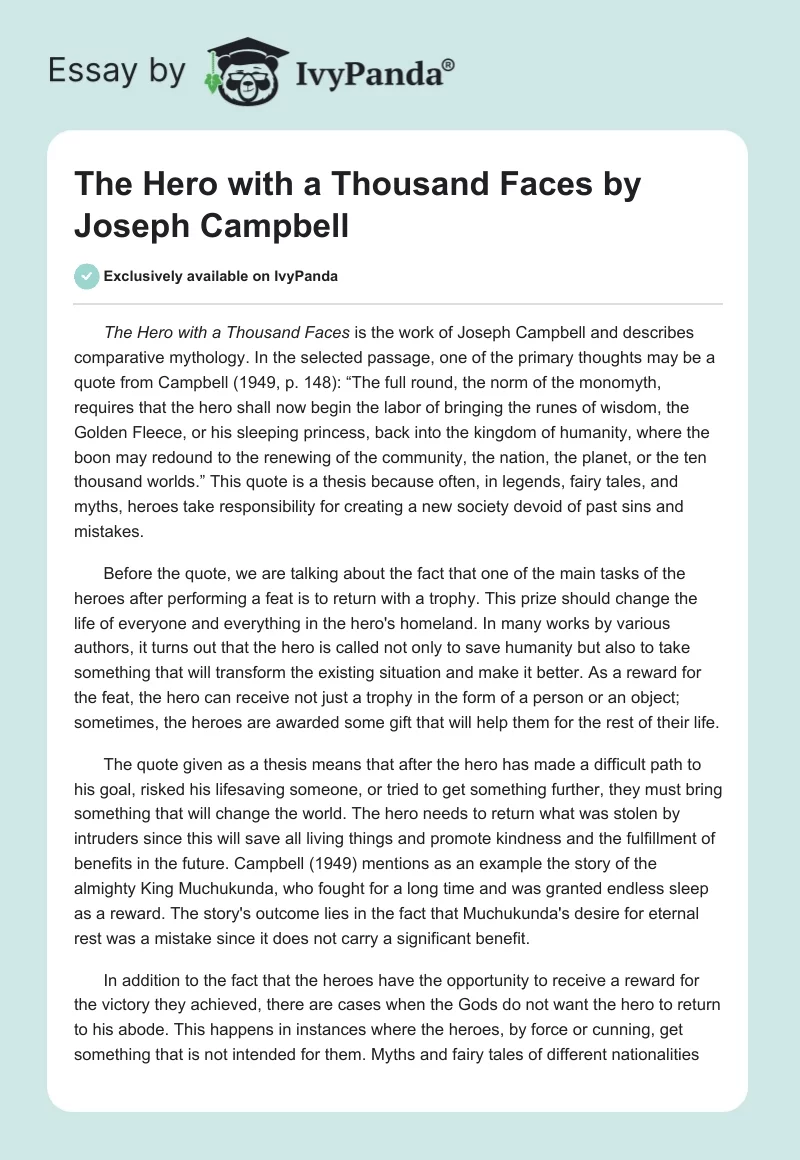The Hero with a Thousand Faces is the work of Joseph Campbell and describes comparative mythology. In the selected passage, one of the primary thoughts may be a quote from Campbell (1949, p. 148): “The full round, the norm of the monomyth, requires that the hero shall now begin the labor of bringing the runes of wisdom, the Golden Fleece, or his sleeping princess, back into the kingdom of humanity, where the boon may redound to the renewing of the community, the nation, the planet, or the ten thousand worlds.” This quote is a thesis because often, in legends, fairy tales, and myths, heroes take responsibility for creating a new society devoid of past sins and mistakes.
Before the quote, we are talking about the fact that one of the main tasks of the heroes after performing a feat is to return with a trophy. This prize should change the life of everyone and everything in the hero’s homeland. In many works by various authors, it turns out that the hero is called not only to save humanity but also to take something that will transform the existing situation and make it better. As a reward for the feat, the hero can receive not just a trophy in the form of a person or an object; sometimes, the heroes are awarded some gift that will help them for the rest of their life.
The quote given as a thesis means that after the hero has made a difficult path to his goal, risked his lifesaving someone, or tried to get something further, they must bring something that will change the world. The hero needs to return what was stolen by intruders since this will save all living things and promote kindness and the fulfillment of benefits in the future. Campbell (1949) mentions as an example the story of the almighty King Muchukunda, who fought for a long time and was granted endless sleep as a reward. The story’s outcome lies in the fact that Muchukunda’s desire for eternal rest was a mistake since it does not carry a significant benefit.
In addition to the fact that the heroes have the opportunity to receive a reward for the victory they achieved, there are cases when the Gods do not want the hero to return to his abode. This happens in instances where the heroes, by force or cunning, get something that is not intended for them. Myths and fairy tales of different nationalities are based on the main character’s pursuit, persecution, and struggle with a god, goddess, or demon (Campbell, 1949). Naturally, this is significant and interesting for readers since the outcome of the chase is unknown to anyone.
In conclusion, Joseph Campbell’s work entitled The Hero with a Thousand Faces contains myths about different countries and peoples. One of the primary thoughts of the selected passage of the work is the episode where the hero is decorated not only by his bravery, courage, and perfect feat. He should also bring with him something that will improve society’s life and enrich them with knowledge and spirituality. As a trophy, there can be a person, an object, or even a gift that the gods present to the main character for merit. Nevertheless, there are well-established norms that are inherent in the main character and that are observed in different countries when writing myths.
Reference
Campbell, J. (1949). The Hero with a Thousand Faces. HarperCollins.


